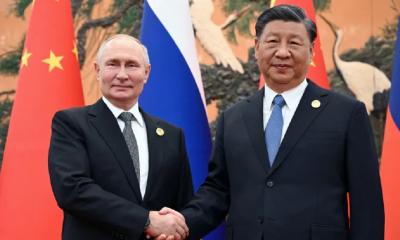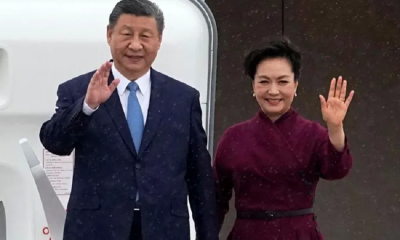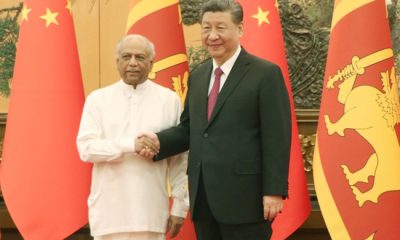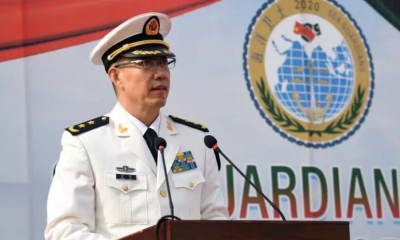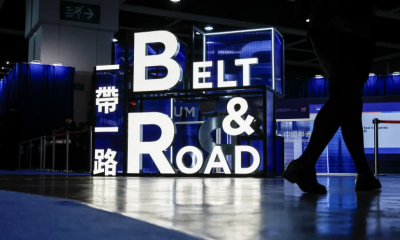Features
Belt and Road Initiative: Is China’s trillion-dollar gamble to transform the world working?
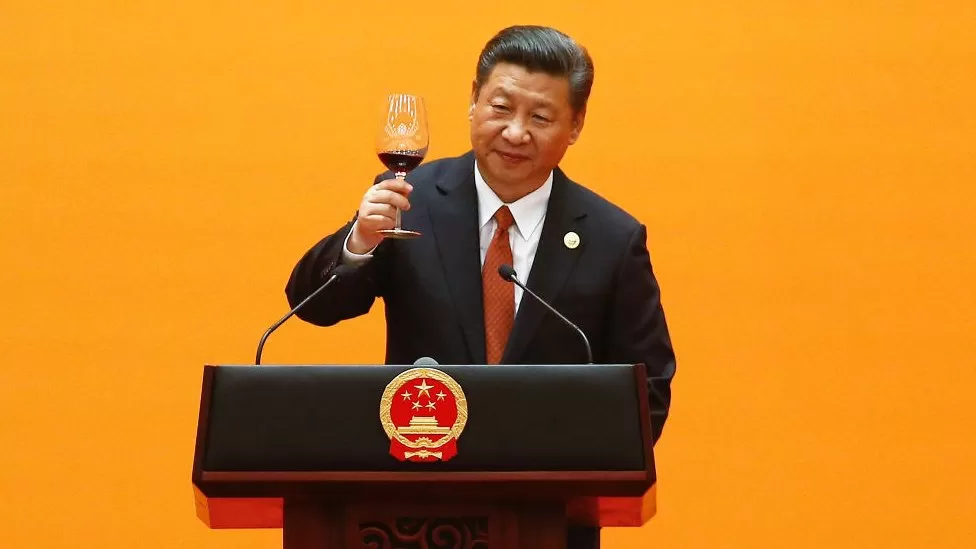
This week, China is throwing a huge party to celebrate one of its biggest experiments in engaging with the world: its Belt and Road Initiative (BRI).
Officials and leaders from all over the globe are in Beijing to attend a high-level summit marking the BRI’s 10th anniversary. Participants expected to show up range from Vladimir Putin to the Taliban. Chinese media is awash with coverage of the BRI’s achievements, including a six-part documentary on state TV.
A signature policy of President Xi Jinping, the BRI is aimed at stitching China closer to the world through investments and infrastructure projects. With an unprecedented glut of cash pumped into nearly 150 countries, China boasts it has transformed the world – and it is not wrong.
But Beijing’s massive gamble hasn’t entirely gone the way it had hoped. Was it worth it?
From the moment the BRI was unveiled in 2013 with comparisons to the ancient Silk Road, it was clear China had sprawling ambitions.
“Belt” refers to overland routes connecting China to Europe through Central Asia, as well as to South Asia and South East Asia; while “Road” denotes a maritime network linking China to major ports through Asia to Africa and Europe.
It started off with heavy state-driven investment into hard infrastructure abroad. Most of the estimated $1tn (£820bn) has been poured into energy and transport projects, such as power plants and railways.

Kenya’s $5bn railway project, funded by Chinese loans, is in danger of becoming a white elephant (pic BBC)
Beijing touted this as an economic win-win – it told other countries these investments would stimulate development, while at home it sold the BRI as a way to help Chinese companies, boost the economy and burnish the country’s reputation.
It had limited success in meeting some goals, such as internationalising the yuan and solving Chinese companies’ overcapacity.
But China reaped a huge economic benefit in trade. A slew of agreements brought access to more resources such as oil, gas and minerals, especially as the BRI’s focus widened to include Africa, South America and the Middle East. About $19.1tn of goods were traded between China and BRI countries in the past decade.
“It’s about Chinese state-owned enterprises going abroad… to help facilitate the flow of resources that China needs,” said Jacob Gunter, a senior analyst at the Mercator Institute for China Studies. “It’s also about expanding and developing export markets as alternatives to the liberal developed world.”
This diversification has become crucial at a time when China faces greater tensions with the West and their allies.
Take soybeans for example. China, the world’s biggest importer, used to rely heavily on the US for supplies. But a tariff war with Washington forced Beijing to turn to South American sources, especially Brazil, estimated to be the region’s largest recipient of BRI funding.
Gas pipelines from Central Asia and Russia – and oil imports from Russia, Iraq, Brazil and Oman – have reduced Chinese dependence on Japan, South Korea and the US, according to the International Institute for Strategic Studies (IISS).
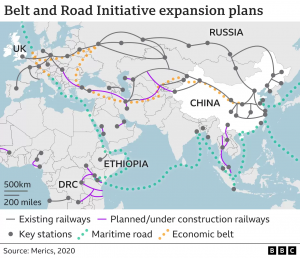
‘Debt trap’ diplomacy
Having become the lender of first resort for many low or middle income countries through the BRI, China is now the world’s biggest international creditor.
The true scale of the debt – thought to be at least hundreds of billions of dollars – is unknown because many of the loan agreements are shrouded in secrecy.
Now, from Sri Lanka and the Maldives to Laos and Kenya, countries are struggling with BRI debt. This puts the Chinese government in a tight spot.
A real estate crisis and liberal borrowing by local governments has already created a “debt bomb” domestically – it’s estimated to run into trillions of dollars. A sluggish post Covid economy and record youth unemployment have not helped.
China has restructured BRI loans, extended deadlines and forked out an estimated $240bn to help borrowers make payments on time. But it has refused to cancel the debt.
“For China to simultaneously engage in debt write-downs overseas while domestic economic issues are not fully resolved – it will be politically challenging internally to promote that,” said Christoph Nedopil, founding director of the Green Finance and Development Center (GFDC), which tracks BRI spending.
This has marred Beijing’s reputation. Some critics accuse China of engaging in “debt trap diplomacy” by luring poorer countries to sign up for expensive projects so that Beijing could eventually seize control of assets put up as collateral. This was the US’ accusation over the controversial Hambantota port project in Sri Lanka.
Many analysts argue there is little evidence of this, but it has heightened fears that Beijing is using the BRI to undermine others’ sovereignty.
China has also been criticised over its so-called “hidden debts” – governments don’t know how exposed their borrowing institutions are, which makes it difficult for countries to weigh up the BRI’s costs and benefits.

Over the years BRI projects have also been accused of creating wasteful “white elephants”, fuelling local corruption, exacerbating environmental problems, exploiting workers, and failing to live up to promises of bringing jobs and prosperity to local communities.
One recent study by research lab Aid Data found more than a third of the projects face such problems. A growing backlash has prompted some countries like Malaysia and Tanzania to cancel BRI deals.
“Poor risk management and a lack of attention to detail and cohesion” from Chinese lenders and companies are partly to blame, according to the Council on Foreign Relations.
But other observers point out the borrowing countries are also to blame, like in the Hambantota case which was partly caused by Sri Lanka’s own financial mismanagement.
They also say China gives resources with fewer strings attached, which is less onerous than offers from global lenders or the West.
“China shows up with a ‘one-stop shop’ approach: ‘Here are our banks and companies and we do everything from start to finish, and if you sign today we will finish that railway, and it will be done in time just as you campaign for your next election’,” pointed out Mr Gunter.
“It’s a huge selling point to say that you can do it in one to three years with very little paperwork. Maybe it’ll be a bit dirty and there may be labour rights violations, but your railway will be done.”
Yet China has met one of its biggest goals – extending its influence.
It is not just through railways and highways that China has created connections. Beijing projects soft power and positions itself as a leader in the Global South, paying for thousands of Chinese university scholarships, cultural exchange programmes and Confucius Institutes. The expansion of the Brics trading bloc too has been credited to China.
Pew Research found that in the past decade many middle-income countries have increasingly favourable attitudes towards China, including Mexico, Argentina, South Africa, Kenya and Nigeria.
Mr Gunter noted that increasingly, countries in the Global South do not wish to choose sides in the US-China rivalry. “China hasn’t flipped many countries from a Western orientation, but the fact it has moved the needle to a middle ground – that is already a huge diplomatic victory for Beijing,” he said.
But observers have also raised concerns of possible economic coercion, where foreign governments feel pressured to follow Beijing’s agenda or risk China pulling out investment.
One Aid Data study of Chinese state-owned entities’ loans to foreign governments found contract clauses that “potentially allow the lenders to influence debtors’ domestic and foreign policies”.
In the UN, China has “corralled other states into temporary coalitions” to oppose measures critical of Beijing, while participation in the BRI has led several EU members to block or water down policies critical of China, pointed out the IISS.
The think tank also said the BRI has become one of China’s “main instruments” in its diplomatic isolation of Taiwan. Many nations that have shifted recognition from Taiwan to China in the past decade are BRI funding recipients, it noted.
In South East Asia, Cambodia has consistently resisted condemnation of China’s actions in the South China Sea, while Laos and Thailand have been criticised for arresting or allowing the abduction of Chinese activists wanted by Beijing.
China now recognises some things need to change.
Beijing preaches the mantra of “small and beautiful” where, through low-investment, high-yield projects, the BRI can have more relevance.
Examples given by state media include bamboo and rattan-weaving programmes in Liberia, biogas technology projects in Tonga and Samoa, and promoting mushroom-growing technology in Fiji, Papua New Guinea and Rwanda.
China has also announced a new “digital silk road” focused on telecommunication and digital infrastructure. Analysts say this would be a more sustainable stream of profits for Chinese companies, while lessening the impact of Western bans on Chinese 5G equipment.
With this new strategy, China has cut down financing. It has imposed limits on external lending by Chinese banks, and investment deals are now nearly 50% smaller than they were five years ago, according to a GFDC analysis. It has also moved away from being the only creditor in the BRI, and started a platform where other countries can lend money.
But Beijing has even grander plans for the BRI, which it now touts as the foundation of “the global community of shared future”.
In two white papers released this month, Beijing said its form of globalisation would be fairer, more inclusive and less judgmental than the one led by “hegemonic” Western powers which seek a “zero-sum game”.
“The BRI is a public road open to all, not a private path owned by any single party,” it said. Far from seeking domination as critics say, China claimed it is “helping others to succeed while seeking our own success”.
The view from China is that “now globalisation is in danger. The West, in the name of ‘de-risking’, is actually ‘de-China-risking’,” said Wang Yiwei, a professor who studies the BRI at Renmin University of China. The main challenge “is how can the BRI build mutual connectivity and avoid a new Cold War”.
Beijing’s trillion-dollar experiment has created a powerful tool to wield influence. But the question is whether the world wants a Chinese-led world order.
(BBC)
Features
The heart-friendly health minister

by Dr Gotabhya Ranasinghe
Senior Consultant Cardiologist
National Hospital Sri Lanka
When we sought a meeting with Hon Dr. Ramesh Pathirana, Minister of Health, he graciously cleared his busy schedule to accommodate us. Renowned for his attentive listening and deep understanding, Minister Pathirana is dedicated to advancing the health sector. His openness and transparency exemplify the qualities of an exemplary politician and minister.
Dr. Palitha Mahipala, the current Health Secretary, demonstrates both commendable enthusiasm and unwavering support. This combination of attributes makes him a highly compatible colleague for the esteemed Minister of Health.
Our discussion centered on a project that has been in the works for the past 30 years, one that no other minister had managed to advance.
Minister Pathirana, however, recognized the project’s significance and its potential to revolutionize care for heart patients.
The project involves the construction of a state-of-the-art facility at the premises of the National Hospital Colombo. The project’s location within the premises of the National Hospital underscores its importance and relevance to the healthcare infrastructure of the nation.
This facility will include a cardiology building and a tertiary care center, equipped with the latest technology to handle and treat all types of heart-related conditions and surgeries.
Securing funding was a major milestone for this initiative. Minister Pathirana successfully obtained approval for a $40 billion loan from the Asian Development Bank. With the funding in place, the foundation stone is scheduled to be laid in September this year, and construction will begin in January 2025.
This project guarantees a consistent and uninterrupted supply of stents and related medications for heart patients. As a result, patients will have timely access to essential medical supplies during their treatment and recovery. By securing these critical resources, the project aims to enhance patient outcomes, minimize treatment delays, and maintain the highest standards of cardiac care.
Upon its fruition, this monumental building will serve as a beacon of hope and healing, symbolizing the unwavering dedication to improving patient outcomes and fostering a healthier society.We anticipate a future marked by significant progress and positive outcomes in Sri Lanka’s cardiovascular treatment landscape within the foreseeable timeframe.
Features
A LOVING TRIBUTE TO JESUIT FR. ALOYSIUS PIERIS ON HIS 90th BIRTHDAY

by Fr. Emmanuel Fernando, OMI
Jesuit Fr. Aloysius Pieris (affectionately called Fr. Aloy) celebrated his 90th birthday on April 9, 2024 and I, as the editor of our Oblate Journal, THE MISSIONARY OBLATE had gone to press by that time. Immediately I decided to publish an article, appreciating the untiring selfless services he continues to offer for inter-Faith dialogue, the renewal of the Catholic Church, his concern for the poor and the suffering Sri Lankan masses and to me, the present writer.
It was in 1988, when I was appointed Director of the Oblate Scholastics at Ampitiya by the then Oblate Provincial Fr. Anselm Silva, that I came to know Fr. Aloy more closely. Knowing well his expertise in matters spiritual, theological, Indological and pastoral, and with the collaborative spirit of my companion-formators, our Oblate Scholastics were sent to Tulana, the Research and Encounter Centre, Kelaniya, of which he is the Founder-Director, for ‘exposure-programmes’ on matters spiritual, biblical, theological and pastoral. Some of these dimensions according to my view and that of my companion-formators, were not available at the National Seminary, Ampitiya.
Ever since that time, our Oblate formators/ accompaniers at the Oblate Scholasticate, Ampitiya , have continued to send our Oblate Scholastics to Tulana Centre for deepening their insights and convictions regarding matters needed to serve the people in today’s context. Fr. Aloy also had tried very enthusiastically with the Oblate team headed by Frs. Oswald Firth and Clement Waidyasekara to begin a Theologate, directed by the Religious Congregations in Sri Lanka, for the contextual formation/ accompaniment of their members. It should very well be a desired goal of the Leaders / Provincials of the Religious Congregations.
Besides being a formator/accompanier at the Oblate Scholasticate, I was entrusted also with the task of editing and publishing our Oblate journal, ‘The Missionary Oblate’. To maintain the quality of the journal I continue to depend on Fr. Aloy for his thought-provoking and stimulating articles on Biblical Spirituality, Biblical Theology and Ecclesiology. I am very grateful to him for his generous assistance. Of late, his writings on renewal of the Church, initiated by Pope St. John XX111 and continued by Pope Francis through the Synodal path, published in our Oblate journal, enable our readers to focus their attention also on the needed renewal in the Catholic Church in Sri Lanka. Fr. Aloy appreciated very much the Synodal path adopted by the Jesuit Pope Francis for the renewal of the Church, rooted very much on prayerful discernment. In my Religious and presbyteral life, Fr.Aloy continues to be my spiritual animator / guide and ongoing formator / acccompanier.
Fr. Aloysius Pieris, BA Hons (Lond), LPh (SHC, India), STL (PFT, Naples), PhD (SLU/VC), ThD (Tilburg), D.Ltt (KU), has been one of the eminent Asian theologians well recognized internationally and one who has lectured and held visiting chairs in many universities both in the West and in the East. Many members of Religious Congregations from Asian countries have benefited from his lectures and guidance in the East Asian Pastoral Institute (EAPI) in Manila, Philippines. He had been a Theologian consulted by the Federation of Asian Bishops’ Conferences for many years. During his professorship at the Gregorian University in Rome, he was called to be a member of a special group of advisers on other religions consulted by Pope Paul VI.
Fr. Aloy is the author of more than 30 books and well over 500 Research Papers. Some of his books and articles have been translated and published in several countries. Among those books, one can find the following: 1) The Genesis of an Asian Theology of Liberation (An Autobiographical Excursus on the Art of Theologising in Asia, 2) An Asian Theology of Liberation, 3) Providential Timeliness of Vatican 11 (a long-overdue halt to a scandalous millennium, 4) Give Vatican 11 a chance, 5) Leadership in the Church, 6) Relishing our faith in working for justice (Themes for study and discussion), 7) A Message meant mainly, not exclusively for Jesuits (Background information necessary for helping Francis renew the Church), 8) Lent in Lanka (Reflections and Resolutions, 9) Love meets wisdom (A Christian Experience of Buddhism, 10) Fire and Water 11) God’s Reign for God’s poor, 12) Our Unhiddden Agenda (How we Jesuits work, pray and form our men). He is also the Editor of two journals, Vagdevi, Journal of Religious Reflection and Dialogue, New Series.
Fr. Aloy has a BA in Pali and Sanskrit from the University of London and a Ph.D in Buddhist Philosophy from the University of Sri Lankan, Vidyodaya Campus. On Nov. 23, 2019, he was awarded the prestigious honorary Doctorate of Literature (D.Litt) by the Chancellor of the University of Kelaniya, the Most Venerable Welamitiyawe Dharmakirthi Sri Kusala Dhamma Thera.
Fr. Aloy continues to be a promoter of Gospel values and virtues. Justice as a constitutive dimension of love and social concern for the downtrodden masses are very much noted in his life and work. He had very much appreciated the commitment of the late Fr. Joseph (Joe) Fernando, the National Director of the Social and Economic Centre (SEDEC) for the poor.
In Sri Lanka, a few religious Congregations – the Good Shepherd Sisters, the Christian Brothers, the Marist Brothers and the Oblates – have invited him to animate their members especially during their Provincial Congresses, Chapters and International Conferences. The mainline Christian Churches also have sought his advice and followed his seminars. I, for one, regret very much, that the Sri Lankan authorities of the Catholic Church –today’s Hierarchy—- have not sought Fr.
Aloy’s expertise for the renewal of the Catholic Church in Sri Lanka and thus have not benefited from the immense store of wisdom and insight that he can offer to our local Church while the Sri Lankan bishops who governed the Catholic church in the immediate aftermath of the Second Vatican Council (Edmund Fernando OMI, Anthony de Saram, Leo Nanayakkara OSB, Frank Marcus Fernando, Paul Perera,) visited him and consulted him on many matters. Among the Tamil Bishops, Bishop Rayappu Joseph was keeping close contact with him and Bishop J. Deogupillai hosted him and his team visiting him after the horrible Black July massacre of Tamils.
Features
A fairy tale, success or debacle

Sri Lanka-Singapore Free Trade Agreement
By Gomi Senadhira
senadhiragomi@gmail.com
“You might tell fairy tales, but the progress of a country cannot be achieved through such narratives. A country cannot be developed by making false promises. The country moved backward because of the electoral promises made by political parties throughout time. We have witnessed that the ultimate result of this is the country becoming bankrupt. Unfortunately, many segments of the population have not come to realize this yet.” – President Ranil Wickremesinghe, 2024 Budget speech
Any Sri Lankan would agree with the above words of President Wickremesinghe on the false promises our politicians and officials make and the fairy tales they narrate which bankrupted this country. So, to understand this, let’s look at one such fairy tale with lots of false promises; Ranil Wickremesinghe’s greatest achievement in the area of international trade and investment promotion during the Yahapalana period, Sri Lanka-Singapore Free Trade Agreement (SLSFTA).
It is appropriate and timely to do it now as Finance Minister Wickremesinghe has just presented to parliament a bill on the National Policy on Economic Transformation which includes the establishment of an Office for International Trade and the Sri Lanka Institute of Economics and International Trade.
Was SLSFTA a “Cleverly negotiated Free Trade Agreement” as stated by the (former) Minister of Development Strategies and International Trade Malik Samarawickrama during the Parliamentary Debate on the SLSFTA in July 2018, or a colossal blunder covered up with lies, false promises, and fairy tales? After SLSFTA was signed there were a number of fairy tales published on this agreement by the Ministry of Development Strategies and International, Institute of Policy Studies, and others.
However, for this article, I would like to limit my comments to the speech by Minister Samarawickrama during the Parliamentary Debate, and the two most important areas in the agreement which were covered up with lies, fairy tales, and false promises, namely: revenue loss for Sri Lanka and Investment from Singapore. On the other important area, “Waste products dumping” I do not want to comment here as I have written extensively on the issue.
1. The revenue loss
During the Parliamentary Debate in July 2018, Minister Samarawickrama stated “…. let me reiterate that this FTA with Singapore has been very cleverly negotiated by us…. The liberalisation programme under this FTA has been carefully designed to have the least impact on domestic industry and revenue collection. We have included all revenue sensitive items in the negative list of items which will not be subject to removal of tariff. Therefore, 97.8% revenue from Customs duty is protected. Our tariff liberalisation will take place over a period of 12-15 years! In fact, the revenue earned through tariffs on goods imported from Singapore last year was Rs. 35 billion.
The revenue loss for over the next 15 years due to the FTA is only Rs. 733 million– which when annualised, on average, is just Rs. 51 million. That is just 0.14% per year! So anyone who claims the Singapore FTA causes revenue loss to the Government cannot do basic arithmetic! Mr. Speaker, in conclusion, I call on my fellow members of this House – don’t mislead the public with baseless criticism that is not grounded in facts. Don’t look at petty politics and use these issues for your own political survival.”
I was surprised to read the minister’s speech because an article published in January 2018 in “The Straits Times“, based on information released by the Singaporean Negotiators stated, “…. With the FTA, tariff savings for Singapore exports are estimated to hit $10 million annually“.
As the annual tariff savings (that is the revenue loss for Sri Lanka) calculated by the Singaporean Negotiators, Singaporean $ 10 million (Sri Lankan rupees 1,200 million in 2018) was way above the rupees’ 733 million revenue loss for 15 years estimated by the Sri Lankan negotiators, it was clear to any observer that one of the parties to the agreement had not done the basic arithmetic!
Six years later, according to a report published by “The Morning” newspaper, speaking at the Committee on Public Finance (COPF) on 7th May 2024, Mr Samarawickrama’s chief trade negotiator K.J. Weerasinghehad had admitted “…. that forecasted revenue loss for the Government of Sri Lanka through the Singapore FTA is Rs. 450 million in 2023 and Rs. 1.3 billion in 2024.”
If these numbers are correct, as tariff liberalisation under the SLSFTA has just started, we will pass Rs 2 billion very soon. Then, the question is how Sri Lanka’s trade negotiators made such a colossal blunder. Didn’t they do their basic arithmetic? If they didn’t know how to do basic arithmetic they should have at least done their basic readings. For example, the headline of the article published in The Straits Times in January 2018 was “Singapore, Sri Lanka sign FTA, annual savings of $10m expected”.
Anyway, as Sri Lanka’s chief negotiator reiterated at the COPF meeting that “…. since 99% of the tariffs in Singapore have zero rates of duty, Sri Lanka has agreed on 80% tariff liberalisation over a period of 15 years while expecting Singapore investments to address the imbalance in trade,” let’s turn towards investment.
Investment from Singapore
In July 2018, speaking during the Parliamentary Debate on the FTA this is what Minister Malik Samarawickrama stated on investment from Singapore, “Already, thanks to this FTA, in just the past two-and-a-half months since the agreement came into effect we have received a proposal from Singapore for investment amounting to $ 14.8 billion in an oil refinery for export of petroleum products. In addition, we have proposals for a steel manufacturing plant for exports ($ 1 billion investment), flour milling plant ($ 50 million), sugar refinery ($ 200 million). This adds up to more than $ 16.05 billion in the pipeline on these projects alone.
And all of these projects will create thousands of more jobs for our people. In principle approval has already been granted by the BOI and the investors are awaiting the release of land the environmental approvals to commence the project.
I request the Opposition and those with vested interests to change their narrow-minded thinking and join us to develop our country. We must always look at what is best for the whole community, not just the few who may oppose. We owe it to our people to courageously take decisions that will change their lives for the better.”
According to the media report I quoted earlier, speaking at the Committee on Public Finance (COPF) Chief Negotiator Weerasinghe has admitted that Sri Lanka was not happy with overall Singapore investments that have come in the past few years in return for the trade liberalisation under the Singapore-Sri Lanka Free Trade Agreement. He has added that between 2021 and 2023 the total investment from Singapore had been around $162 million!
What happened to those projects worth $16 billion negotiated, thanks to the SLSFTA, in just the two-and-a-half months after the agreement came into effect and approved by the BOI? I do not know about the steel manufacturing plant for exports ($ 1 billion investment), flour milling plant ($ 50 million) and sugar refinery ($ 200 million).
However, story of the multibillion-dollar investment in the Petroleum Refinery unfolded in a manner that would qualify it as the best fairy tale with false promises presented by our politicians and the officials, prior to 2019 elections.
Though many Sri Lankans got to know, through the media which repeatedly highlighted a plethora of issues surrounding the project and the questionable credentials of the Singaporean investor, the construction work on the Mirrijiwela Oil Refinery along with the cement factory began on the24th of March 2019 with a bang and Minister Ranil Wickremesinghe and his ministers along with the foreign and local dignitaries laid the foundation stones.
That was few months before the 2019 Presidential elections. Inaugurating the construction work Prime Minister Ranil Wickremesinghe said the projects will create thousands of job opportunities in the area and surrounding districts.
The oil refinery, which was to be built over 200 acres of land, with the capacity to refine 200,000 barrels of crude oil per day, was to generate US$7 billion of exports and create 1,500 direct and 3,000 indirect jobs. The construction of the refinery was to be completed in 44 months. Four years later, in August 2023 the Cabinet of Ministers approved the proposal presented by President Ranil Wickremesinghe to cancel the agreement with the investors of the refinery as the project has not been implemented! Can they explain to the country how much money was wasted to produce that fairy tale?
It is obvious that the President, ministers, and officials had made huge blunders and had deliberately misled the public and the parliament on the revenue loss and potential investment from SLSFTA with fairy tales and false promises.
As the president himself said, a country cannot be developed by making false promises or with fairy tales and these false promises and fairy tales had bankrupted the country. “Unfortunately, many segments of the population have not come to realize this yet”.
(The writer, a specialist and an activist on trade and development issues . )


